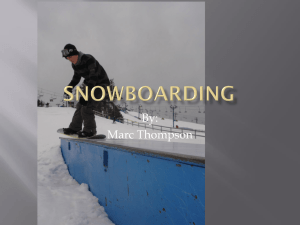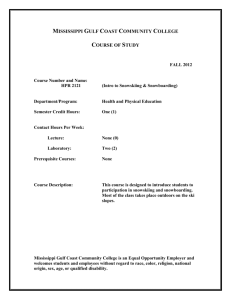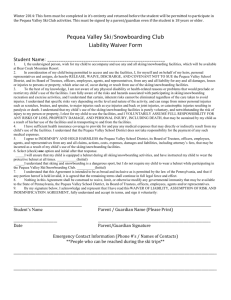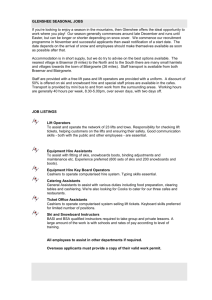Snowboarders: Bodies out of
advertisement
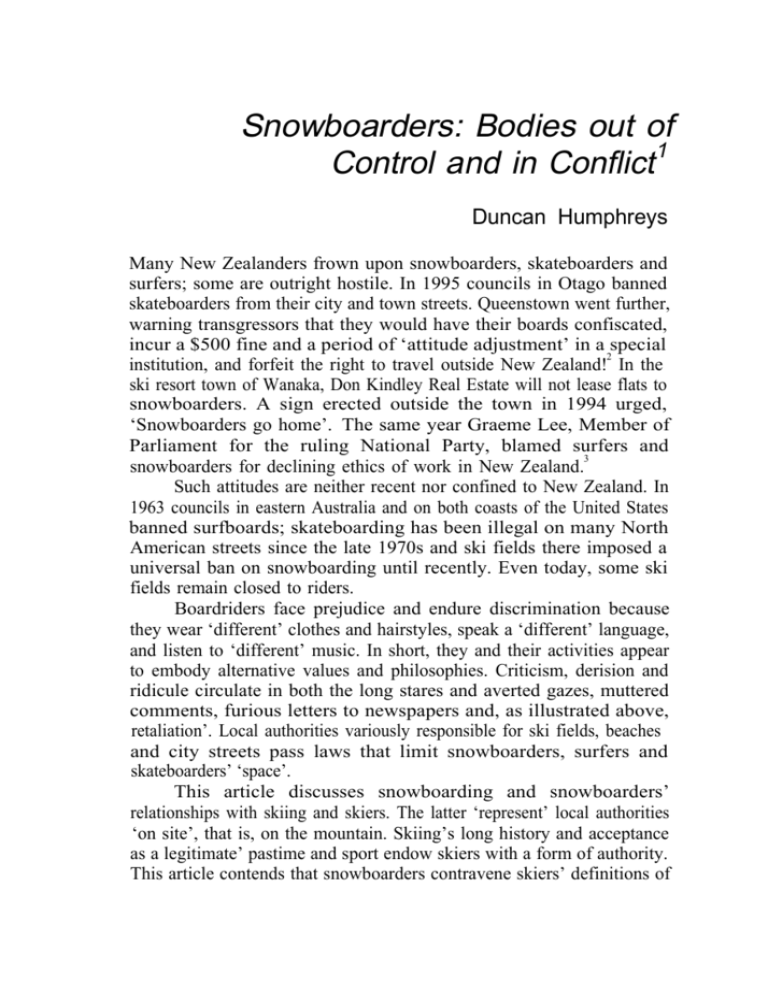
Snowboarders: Bodies out of Control and in Conflict1 Duncan Humphreys Many New Zealanders frown upon snowboarders, skateboarders and surfers; some are outright hostile. In 1995 councils in Otago banned skateboarders from their city and town streets. Queenstown went further, warning transgressors that they would have their boards confiscated, incur a $500 fine and a period of ‘attitude adjustment’ in a special 2 institution, and forfeit the right to travel outside New Zealand! In the ski resort town of Wanaka, Don Kindley Real Estate will not lease flats to snowboarders. A sign erected outside the town in 1994 urged, ‘Snowboarders go home’. The same year Graeme Lee, Member of Parliament for the ruling National Party, blamed surfers and 3 snowboarders for declining ethics of work in New Zealand. Such attitudes are neither recent nor confined to New Zealand. In 1963 councils in eastern Australia and on both coasts of the United States banned surfboards; skateboarding has been illegal on many North American streets since the late 1970s and ski fields there imposed a universal ban on snowboarding until recently. Even today, some ski fields remain closed to riders. Boardriders face prejudice and endure discrimination because they wear ‘different’ clothes and hairstyles, speak a ‘different’ language, and listen to ‘different’ music. In short, they and their activities appear to embody alternative values and philosophies. Criticism, derision and ridicule circulate in both the long stares and averted gazes, muttered comments, furious letters to newspapers and, as illustrated above, retaliation’. Local authorities variously responsible for ski fields, beaches and city streets pass laws that limit snowboarders, surfers and skateboarders’ ‘space’. This article discusses snowboarding and snowboarders’ relationships with skiing and skiers. The latter ‘represent’ local authorities ‘on site’, that is, on the mountain. Skiing’s long history and acceptance as a legitimate’ pastime and sport endow skiers with a form of authority. This article contends that snowboarders contravene skiers’ definitions of 4 Sporting Traditions • vol. 13 no. 1 • Nov. 1996 what constitutes ‘acceptable bodies’. This article also attempts to situate these relationships within changes in late capitalism and its profound impact on society over the last fifty years. Unregulated Bodies: The Development of Snowboarding Snowboarding, the art of standing upright on a board and manoeuvring it across snow, has existed since at least the 1920s. Early accounts of ‘snowboarding’ report individuals riding planks of wood, sleighs and even cafeteria trays down snow covered hills. The formal roots, however, date from the new leisure movement in the 1960s. The movement embraced activities such as skateboarding, frisbee throwing, hot dog skiing, the recently popularised surfing, and high risk activities like rock climbing and parachuting.4 These were the activities of leisured middle-class youth. Social, political and economic changes in the 1950s and 1960s gave youth the freedom to experiment. In the first instance, the emergence of late, or ‘consumer’,5 capitalism in the post-World War II years signified a change from an economy based on heavy manufacturing to one reliant on consumption.6 Harvey characterises late capitalism before the sharp recession of 1973 as Fordist.7 This consumer-based economy required a new set of social values which conflicted with those associated with the more traditional frugal Protestant work ethic. Whereas industrial society valued thrift and sobriety and postponed gratification (till after death!), late capitalism requires consumption, indulgence and the immediate satisfaction of needs.8 Late capitalism promoted an environment of permissiveness. At the same time, the education system underwent a process of liberalisation, in part a response to the new demands of Fordist production, and encouraged students to investigate, question and challenge.9 Yet, this more tolerant society led to unexpected consequences: When the codes of traditional culture are broken, and new social impulses are set free, they are impossible fully to contain ... raise the slogan of ‘freedom’, and some people will give it an unexpectedly revolutionary accent and content.10 Youth, now free to investigate and question society also found themselves free to be dissatisfied with it.” Social dissatisfaction expressed itself through a plethora of social and political movements including the Humphreys • Snowboarders 5 green, feminist and black power movements. The new leisure movement expressed social dissatisfaction in the realm of sport. Adherents experimented with different forms of leisure that did not conform to prevailing definitions. 12 The new leisure movement involved individualistic, expressionistic and co-operative activities which placed emphasis on fun and personal growth rather than winning. Initially intended as a toy for his children, Sherman Popper created what was to become the first mass-produced snowboard in 1965. He sold it to the Jem Corporation, a bowling ball manufacturer, which launched the board at the beginning of the 1966-7 season. Jem, trying to cash in on the surf boom,13 called it the ‘Snurfer’-a snow surfer. At $US15 it was intended primarily as a toy and sold well (over 100 000 in its first year). However, in the context of the new leisure movement, the Snurfer’s potential as a serious recreational tool and alternative to skiing was explored. Popper organised the first Snurfer competition in early 1968, which ran until the early 1980s. Yet, Snurfers were notoriously difficult to control and this limited their use as serious recreational equipment. They lacked edges and bindings,14 and were steered and stopped by way of a hand-held rope leading from the nose. 15 Consequently, commercial ski fields banned the ‘dangerous’ Snurfers. Despite this, Popper’s Snurfer competitions continued. Racers and spectators hiked one-and-a-half kilometres through back country snow to the competition site on a hill near Muskegan, Michigan.16 This scene became typical as other commercial fields around the US banned snurfing. In order to ‘snurf’, one had to walk. It would be many years before ski fields accepted snowboarding. Surfers and skateboarders both influenced snowboarding. In the early 1960s the general public identified the two activities as ‘wasteful, selfish and irresponsible’, and painted devotees as ‘itinerants’ and ‘louts’.17 Such negative images derived from popular perceptions that surfing and skateboarding were undisciplined, hedonistic activities and lifestyles.18 Indeed, as part of the new leisure movement, many surfers and skaters did subscribe to anti-establishment ‘countercultural’ values and philosophies. Surfing initially influenced snowboarding more than skateboarding. Ski field bans confined snowboarders to powder snow. Surfing and riding in powder require similar body movements. As Jake Burton Carpenter, a snowboarding pioneer, notes, ‘riding a good alpine 6 Sporting Traditions • vol. 13 no. 1 • Nov. 1996 [snow]board in bottomless powder is the closest thing to surfing I’ve come across’.19 Not surprisingly then, snowboards followed surfboard design. In 1970 the American surfer Dimitrije Milovich and partner Wayne Stoveken designed snowboards based on surfboard templates.20 They set up the Winterstick Snowboard company in Utah in 1975 and began selling the first technologically-advanced boards. Shaped like a ‘mini surf-board’ the Winterstick even included a ‘control skeg’.21 Tom Sims (a former top professional skateboarder) and Jake Burton followed Milovich and Stoveken. Both had been modifying Snurfers and experimenting with their own designs since the 1960s, 22 although it was not until the 1970s that they began to manufacture boards. Sims set up a factory in California with surfer Chuck Barfoot in 1976 and initially produced surfboards and skateboards for the Sims range. In 1977 Sims added a Lonnie Toft (a professional skateboarder sponsored by Sims) signature skateboard deck to a polyethylene- moulded base developed by Bob Webber. This was the first Sims snowboard. In the same year Burton set up a snowboard factory at Stratton Mountain, Vermont.23 Under Fordist late capitalism social tolerance grew. The new leisure movement and snowboarding both originated in this environment. As an economic system, however, Fordist late capitalism was rigid and unwieldy. Based on mass production driven by mass consumption, Fordism ‘precluded ... flexibility of design and presumed stable growth in invariant consumer markets’. 24 The crisis of 1973 prompted a reconfiguration from rigid Fordism to a highly flexible post-Fordist system. Emphasis on high volume, standardised mass production changed to a system based on ‘rapid and often highly specialised responses, and adaptability of skills to special purposes’.25 ‘Economies of scale’ were superseded by ‘economies of scope’,26 and capitalist production began to rapidly respond to, and take full advantage of, quick-changing fashions. Large-scale businesses with the capacity for mass production dominated Fordist manufacturing. It was Jem, a giant in the bowling industry, that began producing Snurfers. In the postFordist environment small businesses, such as those that designed and produced snowboards, found new freedom and space to operate. PostFordism gave small snowboarding manufacturers advantages that enabled them to grow and increase profits. However, other restraints hampered snowboard manufacturers. Humphreys • Snowboarders 7 While the new boards gave riders greater control, the ski fields continued to ban them. Fears over liability raised ski field operators’ concerns about snowboards.27 Concomitantly, the US Forest Service defined snowboards as ‘non-directional devices’28 and this exacerbated the popular notion that snowboarders could not control their boards. Indeed, there were well-founded concerns: the Snurfer still remained the most popular snowboard and those riding the new boards had limited skills. Yet, there was a social content to the ban. The public recognised snowboarding as a variant of surfing. Newsweek, in one of the first mainstream media articles on snowboarding, encapsulated this relationship when it warned that ‘surfers, who spend all summer searching for the perfect wave, have now invaded the slopes. They can now spend all winter searching for the perfect snowfall.’29 Ordinarily, the public viewed surfers as social misfits and subversive nomads who searched for waves. The use of drugs and adoption of Eastern religions and mysticism by some ‘soul-surfers’ (allegedly necessary to aid the search for Utopia) fuelled this popular perception in the early 1970s. Soul-surfers embodied the counterculture and hence became ‘rotten, long haired, unwashed drug addicts’.30 Some seaside councils in the US banned surfing in the mid-1960s, and this new image only served to widen the gap between surfers and local councils. Banning snowboarding was thus as much a social sanction as a concern about insurance liability. Milovich discovered this in 1977 when the insurance broker for major US ski areas informed him that regular ski liability did in fact cover snowboards.31 Pierre Bourdieu’s notion of legitimate bodies helps explain the social content of the ban. As already noted, late capitalism promoted tolerance and permissiveness which facilitated lifestyles based on pleasure and consumption. Greater freedom, however, continually ‘raise[s] concems about “correct” behaviour’.32 Hedonism is never unfettered: ‘Leisure relations are relations of permissible behaviour. What is considered legitimate in them is the socially produced effects of structural rules of pleasure and unpleasure.’33 Social standards dictate acceptable pleasure. Of course, not everyone accepts the same standards. Bourdieu refers to this in the context of sport: ‘the field of sporting practices is the site of struggles ... This field is itself part of the larger field of struggles over the definition of the legitimate body and the legitimate use of the body.’34 Central to Bourdieu’s 8 Sporting Traditions • vol. 13 no. 1 • Nov. 1996 concept of the legitimate body is the ability of dominant groups to define themselves as embodying legitimacy, in other words, defining ‘their bodies and lifestyle as superior [and] worthy of reward’.35 Other groups, which use and present their bodies in different ways, challenge the rules and schemes of legitimation. Different uses and presentations of the body not only challenge existing social standards but also challenge the status of dominant groups. For example, snowboarders resist the traditional definition of the dominant skiing body; they challenge skiing’s status as the dominant winter mountain activity, and also the power of skiers to define schemes of legitimacy. Bryan Turner identifies the regulation of bodies as a primary task of any society.36 In popular thought snowboarders are unregulated, out of control, undisciplined, hedonistic and irresponsible. This reflects the dominant group’s status and ability to define social standards. Snowboarding, somehow, promotes disorder in society as a whole rather than simply being an alternative view or practice. Snowboarders do not just constitute a relative difference within society, rather, they are ‘the other’. Skiers can deal with the threat posed by different snow activities in several ways. They can minimise or remove the ‘illegitimate’ through formal sanctions, such as legal restraint, or through criticism and ridicule. Snowboarders have experienced both: they have been banned, restricted and subjected to criticism, prejudice and derision. Opposition to snowboarders was not total. A few ski areas such as the Fairfield Snowbowl (Arizona) allowed snowboards, with the proviso that snowboarders wore skis on the lifts.37 Skis apparently legitimised ‘uncontrolled’ snowboarders. Although many adherents of the new leisure movement skied, for example, surfers, ‘hot dog’ skiers and ski bums, they embodied legitimacy as skiers, rather than as ‘snow-surfers’. Skiers were disciplined bodies, regulated and legitimised by ski manufacturers, ski field managers, administrators, contest officials, coaches, professionals, clubs and a long history. In his study of Australian surfing Douglas Booth narrates an event that demonstrates the power of association with formal sport and its network of manufacturers, administrators and organisations. In 1966, precisely at the same time as a municipal council confirmed bans and restrictions on surfers at beaches under its jurisdiction, councillors approved a civic reception for the new world surfing champion, Nat Young. 38 Snowboarding, however, remained uninstitutionalised and uncodified. It had no links to disciplined Humphreys • Snowboarders 9 sports. It had no formal organising bodies, just one major competition, one major manufacturer (who was more concerned with making bowling balls) and half a dozen smaller manufacturers producing snowboards in their garages. Few regarded snowboarding as a serious recreational activity. The Snurfer was the only snowboard available for competition during the 1970s. Distribution was poor and many potential riders considered the newer boards too expensive. Burton’s boards and the Winterstick sold for around $US80-90 in the late 1970s, compared with $US20 for a Snurfer. Burton first entered the annual Snurfer race at Michigan on his own equipment in 1979. He was the first non-Snurfer entry.39 Moreover, snowboarding still retained the new leisure movement’s philosophy of co-operation, self expression and anti-competition. Snurfer competitions were more social gatherings than rigorous competition. Combined with the fact that the Snurfer was still largely sold as a toy, meant that snowboarding remained in the realm of play. As one observer put it several years later, ‘snowboarding is not about grace and style but about raging hormones. It is adolescent boys with their newest toy.’40 There was a popular perception that riders spent all ‘winter searching for the perfect snowfall’, had abandoned the work ethic and were social burdens. Snowboarders were seen as reneging on adult responsibilities. Kenneth Roberts describes a continuum of independence and responsibility that marks the movement from childhood to adulthood: ‘Childhood is an “unreal” world of tolerated parasitism, legitimate dependence, submission and irresponsibility. As adults, by contrast, individuals are expected to be independent and accept responsibility for their decisions and actions.’41 Mainstream society regarded snowboarders as irresponsible children and snowboarding as illegitimate play. Combined with its uncodified and uninstitutionalised nature, snowboarders were defined as unregulated and irresponsible. Snowboarding became juxtaposed with skiing: skiing embodied technical discipline and control, snowboarding embodied freedom, hedonism and irresponsibility. In many respects the tension between snowboarding and skiing was similar to that between surfing and surf lifesaving in Australia. 42 Snowboarding and surfing both challenged established sports, in this case, skiing and surf lifesaving. Moreover, snowboarding and surfing also challenged the definition of legitimate bodies at the ski fields and beaches. Thus ski fields’ operators either 10 Sporting Traditions • vol. 13 no. 1 • Nov. 1996 banned snowboards or imposed heavy restrictions. The general ban, which lasted until the late 1980s, had several effects. It relegated snowboarding to a fringe activity. At the 1979 Snurfer competition there were only 500 spectators and 230 racers. 43 Although Snurfers had been selling for over a decade, the competition remained a cult event. As mentioned above, snowboarders were forced to either hike up the slopes or devise other solutions. In some instances snowboarding went nocturnal, such as at the Fairfield Snowbowl. Fairfield had opened the piste to snowboarders, although it banned them several weeks later after one of their number got into a fight with a member of a ski-patrol. So snowboarders hitched rides with the snowcats that groomed the piste at night and then rode in the glare of the headlights. 44 This increased the thrills but it also restricted the numbers! On the other hand, it helped consolidate snowboarding’s identity and culture. Participation demanded true commitment. Although snowboarders could ski during the day, which arguably should have weakened their identity, this was mostly not the case. Aaron Bolt remembers the early days of snowboarding in New Zealand: When we started riding it would have been so much easier for me to keep skiing. But you get addicted and keep riding _ it’s a sport you take up and don’t put down.’45 Although few in number, snowboarders were passionate devotees. As an underground activity snowboarding remained separated from the commercial realm. This reinforced the philosophies of the new leisure movement. Whereas a debate between ‘soul surfers’ and professionals raged in surfing from the mid-1960s,46 the snowboarders’ reality was ‘soul-boarding’-riding for intrinsic pleasure. One competition could not sustain professional snowboarding. The ban on snowboards at ski fields left snowboarding manufacturers without the means of promotion and, ultimately, the means of profit. Of course, there were few manufacturers anyway. Snowboarding’s relative isolation limited skiing’s influence and hence snowboarding developed a unique philosophy and identity independent of skiing. Yet, the fringe nature of snowboarding also left garage manufacturers struggling for survival. Milovich went bankrupt in 1984. Only Burton and Sims really survived this period, although Burton was $US100 000 in debt47 and the latter relied on skateboard sales. Separation also meant that surfboard design influenced snowboards Humphreys • Snowboarders 11 more than ski technology. Milovich introduced metal edges to his designs but removed them: We didn’t need them. We were riding in powder over our heads.’48 Some snowboard manufacturers rejected ski technology. Snowboards were for snowboarders and not for skiers as Jake Burton comments: We could make skis, but we don’t want to make skis. We’re not a ski company. We’re a snowboard company. And that’s something we have been right from the beginning, even through some very tough times, when we couldn’t give snowboards away.49 The bans helped preserve the peculiar nature and identity of snowboarding. Snowboarders saw themselves as ‘different’ to skiers and drew their inspiration mainly from surfing and skateboarding. Not only were they not affected by skiers, they retained their oppositional character into the next decade. From Outcasts to Legitimacy After these slow beginnings snowboarding grew in popularity in the mid-1980s. The main influence now was skateboarding. Magazines, such as Skateboarder and Action Now, gave snowboarding national exposure in the US in the early 1980s.50 These largecirculation magazines profiled professional skaters who had recently started snowboarding. Skateboarding thus developed a direct relationship with snowboarding, especially with respect to riding style. For example, Tom Sims built the world’s first snow half pipe in 1983.51 The half pipe, literally the bottom half of a large pipe, is a popular piece of skateboarding equipment. Furthermore Sims, traditionally a skateboard company, released the first freestyle snowboard in 1985, which enabled streetskating tricks on snow. It came as no surprise then that when the first specialist snowboarding magazine appeared in 1985 the publishers chose the title Absolutely Radical. During the 1980s skiing was increasingly associated with the elite. Skaters perceived ski fields as the terrain of the yuppie. Ed Pitoniak, editor of Ski, noted that ‘by the end of the ’80s _ skiing was _ the epitome of yuppie excess’.52 But snowboarding appealed to skateboarders. Approved by professional skaters and containing skateboarding icons and characteristics like Sims (who also produced skateboards) and the half pipe, snowboarding on freestyle boards meant that it maintained a close relationship with skateboarding. 12 Sporting Traditions • vol. 13 no. 1 • Nov. 1996 Skateboarders began to invade the mountains en mass. Snowboarding developed a wide appeal; it simultaneously became ‘surfing on snow’, and the winter activity for skateboarders. Craig Harris, a New Zealand snowboarding pioneer describes what other boardriders see in snowboarding. Skaters and surfers ‘associate what they enjoy of the other sports and put it into snowboarding _ At times, yeah, it feels like surfing, and at others it feels like skating. It’s just looking for the buzz.’53 The mainstream media also gave snowboarding added exposure. For example, in 1979 Paul Graves, a Snurfer professional, rode a Snurfer in a television advertisement for beer which ran a phenomenal four years.54 In 1982 Graves organised the first National Snowsurfing Championships. Held in Vermont, it attracted riders from all over the North America.55 Set against the popularity of skateboarding and Paul Graves’s beer commercial, the contest attracted the attention of Sports Illustrated, NBC Today, and Good Morning America.56 Further competitions followed in 1983. Sims held the inaugural World Championships at Soda Springs (Tahoe, California) and Burton took over the organisation of the national championships from Graves when the latter could not afford to run it for a second year.57 Snowboarding received more major publicity when Tom Sims appeared on a snowboard in the James Bond film A View to a Kill (1984) and in Fire and Ice (1984). Snowboards moved away from the influence of surfboard design in the early 1980s. Manufacturers experimented with metal edges and low friction, hard plastics, such as P-tex, for bases. These enabled snowboarders to ride hard-packed snow. The changes in design were specifically intended to introduce snowboards to the ski fields. Jake Burton claimed that he had only considered taking snowboards into ski resorts after two of his professional riders talked him into trying Stratton Mountain, Vermont.58 Before then powder conditions influenced snowboard design. As mentioned previously, bans had banished snowboarders to backcountry powder. Burton spoke to Stratton Mountain about opening its fields to snowboards for the 1983 season. Burton had been selling snowboards and riding the Vermont area since 1977 and his boards were known to Stratton management. Media coverage of Graves’s competition, which was also held in Vermont, and news of Sims’s World Championships to be held later that year, convinced Stratton to open its doors. It was the first major ski area to do so.59 Coinciding with the opening of Stratton to snowboards, Burton released the first Humphreys • Snowboarders 13 production boards with P-tex bases. Burton later described the model as, ‘a real breakthrough. It was the first board you could really freeride _ on hardpack and _ control your speed.’60 Stratton, however, sought to control snowboarders. It demanded snowboarders take lessons and achieve levels of competency before they could ride on lifts.61 Skiers—who are equally dangerous—had no restraints placed on them. Snowboarders also required leg leashes, ostensibly to prevent boards from sliding away and hitting someone. Leashes made sense in the early 1980s when boards did not have heel straps which anchored the boards to the rider’s feet. However, from the mid-1980s bindings kept the snowboarders foot secured to the board. Interestingly, one of the justifications for banning surfers from beaches was that riderless boards posed a danger to bathers. It was only after the development of leg ropes that councils rescinded the bans.62 Similarly, a criticism of street skaters in the 1990s is that they cannot control their boards. The mandatory leash on snowboards is a form of symbolic shackling; they remind snowboarders that they are under constant discipline. Other fields followed Stratton. By 1989 the majority of ski fields were open to snowboarders. But there was an ulterior motive. Skiing had reached a growth plateau and snowboarding offered ski fields a new youth market and ongoing economic prosperity. Ski summed up the importance of snowboarding when it described it as one of the 100 greatest things that had ever happened to skiing: ‘It attracted a whole new generation of young riders to the ski resorts, giving the ski world a much needed shot in the arm’.63 If snowboarding gave skiing a shot in the arm, opening ski fields gave snowboarding a dose of steroids. In 1988 Burton Snowboards grossed US$13 million.64 Five years earlier Jake Burton had been deep in debt. In 1983 eight or so manufacturers produced boards. By 1988 the number had grown to thirty-five.65 Swatch, the watch manufacturers, began sponsoring snowboarding competitions in 198666 and O’Neill (surf clothing and wetsuits) and Suzuki (four-wheel drive motor vehicles) joined Swatch to sponsor the first World Cup tour of 1987-8. Although post-Fordist late capitalism provided the environment in which snowboarding developed as a series of small businesses, this did not initially ensure the growth of snowboarding. Skiers and ski field management continued to oppose snowboarding. Opposition continued 14 Sporting Traditions • vol. 13 no. 1 • Nov. 1996 well into the 1980s but simply could not be maintained. Snowboarding became an economic force which, combined with the post-Fordist celebration of difference and diversification, meant that ski field managements had to accommodate snowboarders. While this has not significantly changed the definition of what constitutes an acceptable body on the mountain, it at least created space in which snowboarders could pursue their activity. Access to the piste influenced snowboard design and increased the market for snowboards. In just four years the snowboard reached maturity. By 1987 snowboards had completely departed from the surf board design. Boards now resembled Mike Olson’s monoski.67 The fins and swallow tail, which frequently snapped in hard pack, disappeared. Yet, although the snowboard had become a ski, the stance remained unmistakably that of a surfboard rider. With the explosion of popularity snowboarders set up the first formal associations. In 1987 professional riders formed the North American Snowboarding Association (NASBA) and the Snowboarding European Association (SEA);68 the following year Chuck Allen, a cofounder of the National Scholastic Surfing Federation,69 established the United States Amateur Snowboarding Association (USASA). NASBA and the SEA were initially formed to co-ordinate a unified World Cup tour.70 A major objective of USASA, however, was to regulate ‘irresponsible’ snowboarders: ‘our goal is to promote the safe and responsible image of snowboarding’.71 Yet, USASA also sought to combine this positive and responsible image with the original boarding philosophy of co-operation, self-expression and freedom. According to its mission statement USASA supported the ‘responsible growth and development of amateur snowboarding, through competition, while maintaining the fun and unique nature of this new sport’.72 This combination of formal associations, international competitions and relationships with major corporate businesses meant that snowboarding increasingly became seen as a legitimate sport. As one magazine headline of 1988 put it, referring to snowboarding’s previously fringe and unorthodox nature, ‘Shredheads go mainstream’.73 Snowboarding had become regulated; it had become controlled, formalised and codified. Yet, paradoxically, as an economic force, snowboarding created social space for itself. Snowboarders could still challenge legitimate definitions of sport without fear of sanction. In Humphreys • Snowboarders 15 particular snowboarders challenged skiers’ cultural capital. 74 Snowboarders assign little value to skiing. Culturally, philosophically and stylistically skateboarding and surfing influence snowboarding. Snowboarders value a different form of physical capital to skiers: skiers lack the style instincts surfers have-for instance, using their upper bodies to initiate turns. They keep their upper bodies too quiet.75 Some snowboarders even ridicule skiing. Snowboarding therefore challenges skiing’s place as the legitimate winter mountain sport. This caused conflict. Some ski fields remained closed to snowboarders for purely social reasons. Mark Menlove of Park City (Utah) claimed that ‘a lot of skiers tell us that they come here because there are no snowboarders’.76 For many, snowboarders still conjured negative images. A survey of US skiers in 1991 found that 41 per cent felt ‘nervous’ around snowboarders, 43 per cent preferred snowboarders to have their own trails, and 20 per cent wanted boards banned!77 Brad Moretz of Appalachian Ski Mountain (North Carolina) said that snowboarders produce ‘a level of discomfort’ and ‘we are doing everything we can to make skiing as unintimidating as it can be’.78 Snowboarding had been formalised, regulated and controlled. But this did not change the antagonistic views of some skiers and ski management. It was still largely perceived as an irresponsible activity that defied definitions of acceptable sport. Shredheads go mainstream? As the 1980s drew to a close, snowboarders gained access to most ski fields in North America. Snowboarding also diversified with international competitions and professionals attracting sponsorships from large corporations. It also experienced phenomenal growth in the early 1990s. In 1993, for example, sales of boards increased by a third.79 One reason was continued institutionalisation. The ISF joined together a number of existing associations in 1991 and in so doing increased snowboarding’s legitimacy. The main reason for this growth, however, was undoubtedly the commodification of snowboarding and skateboarding subcultures. The increased popularity and visibility of both these activities in the late1980s prompted some companies to exploit snowboarding and skateboarding’s ‘irresponsible’ and ‘uncontrolled’ images and attitudes to sell their products to youth. One example was a new company which 16 Sporting Traditions • vol. 13 no. 1 • Nov. 1996 called itself the ‘Bad Boy Club’. It manufactured clothing and identified itself closely with snowboarding, skateboarding and surfing about this time. Furthermore, by the 1990s skateboarding and snowboarding had developed a very close relationship. Skating gave snowboarding a major impetus through spectacular new tricks and moves as well as ‘a young, aggressive attitude designed to shock and stun’.80 Skateboarding’s ability to shock and disturb came from its ties with deviant and anti-social youth subcultures. Again advertising reflects this trend. One advertisement for Black Flys sunglasses depicts a male with hooks attached to taut strings piercing his nostril, tongue and ear. However, many commentators frown upon the ‘shock’ aspect of snowboarding. Moreover, it generated considerable debate in snowboarding and skiing. Older riders, who had worked hard to gain public, and particularly ski field operators’, acceptance and develop snowboarding as a legitimate activity, wanted to cast a better image of responsible snowboarders. An article in Australian Snowboarding summarised this view: Courtesy of marketing misguidance, detrimental hype and a bad example set by some, there is a great deal of irresponsible riding and anarchistic attitudes to match. Mountain rules are not there to be broken nor is resort property or native fauna. The jib/bonk mentality, ride anything and everything without concern for resort structures and equipment or even personal safety, combined with irresponsible and sexist advertising-depicting how much beer, dope and pomographic reading material you can fit into your new backpack-tarnishes snowboarding’s profile irrevocably.81 This group condemn irresponsibility among snowboarders and demand that riders show greater social consideration and courtesy. Ste’en Webster, editor of New Zealand Snowboarder, is a prominent voice for this group. Snowboarding, like surfing and skateboarding, he says, ‘seem[s] to attract people with an acute ability to bend and even ignore rules’. Some people may consider this ‘creative _ but _ I [don’t] disrespect the ski areas ... It all boils down to common sense and respect’.82 The ‘anarchists’ scoffed. What the hell is this shit about _ manners on the mountain?’, asked one correspondent to Transworld Snowboarding: I thought snowboarding was about tattoos, body piercing, and punk music, not being all nice and shit. What is this, the Brady Bunch girls with snowboards? I think we should be Humphreys • Snowboarders 17 able to cut skiers off. All they do is make fun of us anyway. We should be able to cuss and smoke anywhere we want. And I like pants so big you can carry Greyhound buses in your pockets and no one knows it.83 ‘Anarchists’ are typically younger and newer riders and show little respect. They never had to walk up a mountain slope or plead for access to ski fields and they revel in snowboarding’s rebellious ‘bad boy’ image. This debate also articulates a struggle between residual and emergent subcultures.84 The older riders, the residual culture, wanted to defend their new-found access to the ski fields. The newer riders, the emergent culture, took access for granted. Unconcerned with resort rules and regulations, the latter proceeded to do what they wanted. The older riders also supported the soul-surfer's respect for nature; newer riders tended to follow the skate-based approach of riding everything, including native fauna. The debate between ‘cultures’, then, generally runs along two diametrically opposed philosophical axes-surfing and skating. Complicating this debate, however, was the fracturing of snowboarding into three distinct styles by the late 1980s: freestyling (influenced by skateboarding), alpine (largely influenced by skiing and surfing), and freeriding (a combination of both styles applied mountain wide). Freeriders insist that their style is the essence of snowboarding. They value spontaneity in the selection of styles, whether they are carving a field of powder or performing skate-style jumps off cliffs. They are free to the extent that they do not require a half pipe or piste.85 A freerider used this rather sophisticated metaphor: ‘Shutting yourself off to any one form of boarding is something like going to a wine tasting and sticking to one claret’.86 The most noticeable tension among snowboarders is between freeriders and freestylers, and alpine snowboarders. The former dismiss alpine riders as skiers on boards. New Zealand snowboarder and skater Andrew Morrison defines an alpine rider as ‘someone ... [who] carves, carves, carves and carves and carves’. ‘I don’t have much respect for those guys’, he adds.87 New Zealand snowboarder Aaron Bolt claims that most snowboarders reject disciplined approaches: ‘Most snowboarders don’t snowboard alpine or ride gates. It’s not why they are into snowboarding. It stifles the creativity.’ 88 18 Sporting Traditions • vol. 13 no. 1 • Nov. 1996 Both surfing and skateboarding experienced similar debates. In the late 1960s surfers debated the merits of the Hawaiian style of ‘surfing with nature’ as opposed to the Australian ‘conquer all’ aggressive style.89 In the early 1980s skateboarders debated institutionalisation. One group preferred to maintain an ‘anarchistic’ lifestyle; another wished to legitimatise the image.90 These debates not only resurfaced in snowboarding, but also spilled over into skiing. It was not just the technical style of snowboarding that made skiers ‘nervous’. Skateboarding provided snowboarding with fresh anti-establishment philosophies and contributed to the perception of snowboarders as beyond control. In other words, riders influenced by skateboarding replicate the identical image of the first generation of snowboarders who began riding over twenty years ago. They are playful and irresponsible. As well as bringing spectacular skate-based moves, they also express the critical deviant politics of alternative youth subcultures. All these challenge the dominant definition of sport. This fuelled a general perception that snowboarders are subversive; they are out of control and defy conventional middle-class norms. A handful of resorts subsequently re-banned snowboarding. Articles in the ski media sought solutions to the ‘snowboarding menace’. Of course when the general media seized on the tension between snowboarders and skiers and ski field managements (initiated in part by the very images of irresponsible snowboarders which the media helped promote), it exaggerated the tensions and portrayed them as a full-scale conflict. However, on the whole, ski management showed tolerance towards snowboarders because they recognised riders as a potent economic force. Skiing has stagnated over the last decade; snowboarders, on the other hand, made up 10 per cent of all lift ticket sales in 1993 in North America. Predictions are that this will triple over the next ten years.91 In some cases snowboarders make up more sales. For example, snowboarders at Treble Cone (New Zealand) buy two thirds of season passes.92 Snowboarders also tend to ride all season: in North America riders make up to 60 per cent of early, and 40 per cent of late, season ski field users.93 Snowboarding has become such a force that some ski fields now open only to snowboarders. Raging Buffalo (Illinois) banned skiers during weekdays in 1993, and the Green Valley Ski Area (southern California) is now exclusively a snowboarding resort.94 Furthermore, snowboarding attracts the young while the ski market is rapidly ageing.95 Humphreys • Snowboarders 19 When younger members refused to ski, family-orientated mountains were forced to allow snowboarders.96 Graham Dunbar, a New Zealand snowboard instructor who also teaches at Blackcomb (British Columbia, Canada) claims that he doesn’t ‘see kids learning to ski anymore overseas’.97 Ski fields are currently caught between catering for the economic potential of snowboarding and the economic reality in which skiers are still the main source of income. Consequently, ski field managements attempt to accommodate snowboarders and reconcile both groups. Many fields now conduct mountain education programs to educate skiers about snowboarders and to encourage snowboarders to accept a code of responsibility. In a few cases operators separate snowboarders and skiers by allocating each their own runs. The snowboard park, an adaptation of skate parks with ramps and jumps, also assists with separation. Vail (Colorado) developed the first snowboard park in 1990 as a way to attract freestylers. Other fields quickly followed. As well as separating freestylers, the parks helped control them. An article in Ski Area Management praised snowboard parks for ‘putting snowboarders in their (own) place’.98 Ski fields therefore accommodate, rather than integrate, snowboarding in the interests of profit. Most snowboarders still subscribe to the free, playful, new leisure movement philosophy: in 1995, for example, Burton named its three board styles freeriding, freestyling and freecarving. Snowboarding has also successfully managed to carve its own niche on the ski field, challenging skiing’s position as the dominant and legitimate winter mountain sport. Conclusions Co-existence and conflict rather than acceptance or harmony characterise skier-snowboarder relations. Access to ski fields gave snowboarders greater freedom and made riding ‘easier’. Snowboarders gained access to skiing’s ‘infrastructure’, including chair lifts, a safe riding environment, roads to the ski fields, as well as ski resort towns built by skiers’ patronage. Almost instantly snowboarders could catch a chair lift to the top of their runs, ride all day, return to a warm motel room and drive back to the ski field the next day. Previously snowboarders hiked through backcountry powder to get to the top of a run, faced avalanches and slept in snow caves. But improved 20 Sporting Traditions • vol. 13 no. 1 • Nov. 1996 access and homely comforts came at a price: riders had to wear skis and leashes, and abide by a code of conduct. The backcountry meant freedom; snowboarders could ride where and what they wanted with no concern for offending or threatening others, yet the ski field meant easier and more riding. Snowboarding offered ski fields economic potential. It introduced a new set of consumers to the mountains. Growth encouraged ski field owners and managers to invest more money in their fields by, for example, providing more snowmakers and new buildings, extending the size of ski fields and employing more staff. Snowboarding also revitalised skiing spiritually. It restored skiing's former vitality, especially in the area of ‘trick’ skiing. 99 Snowboarders reminded skiers that the rationale of skiing was fun. Economic growth and revitalised spirituality also imposed a price on skiers. They forced skiers to tolerate snowboarders-the others. This is the site of conflict. Snowboarders resist and challenge skiing’s hegemony. On one hand, skiing is, and will remain, the dominant snow activity due to its long history and strong tradition in Europe and the US. On the other, snowboarding is an example of an activity retaining, across time, an embodiment of illegitimate difference. This in turn suggests that in the future, boardriding will continue to be characterised by social unacceptance. Hence, antagonisms between these two groups seem certain to persist. NOTES: 1 I would like to gratefully acknowledge the guidance that Dr Douglas Booth has given me during the research and writing of this article. 2 ‘Queenstown Skateboarders Reprieve’, Otago Daily Times, 15 June 1995. The threat was issued to skateboarders through a leaflet written by a local businessman and circulated in snow and skateboard shops in Queenstown in June 1995. Of course, local councils do not have the authority to impose such penalties. 3 ‘Skiers and Surfers on Dole “have no Shame”’, Otago Daily Times, 15 June 1994. While the title refers to skiers, the text only discusses snowboarders. 4 Peter Donnelly, ‘Sport as a Site of “Popular” Resistance’, in R Gruneau, ed., Popular Cultures and Political Practices, Garamond Press, Toronto, 1988, p. 74. 5 Mike Featherstone, Consumer Culture and Postmodernism, Sage, London, 1991. 6 David Harvey, The Condition of Postmodernity, Basil Blackwell, Oxford, 1989, pp. 133-7. 7 Harvey, The Condition of Postmodernity, p. 124. 8 J Clarke, S Hall, T Jefferson and B Roberts, ‘Subcultures, Cultures and Class’, in S Hall and T Jefferson, eds., Resistance Through Rituals, Routledge, London, 1976, p. 64. 9 Douglas Booth, ‘Surfing 60s’, Australian Historical Studies, no. 103,1994, p. 274. 10 Clarke et al, ‘Subcultures’, p. 67. Humphreys • Snowboarders 21 11 Booth, ‘Surfing 60s’, p. 274. 12 Donnelly, Popular Cultures and Political Practices. 13 J Irwin, Surfing: The Natural History of an Urban Scene’, Urban Life and Culture, vol. 2, no. 2, 1973, pp. 143-5. 14 Weiss, Snowboarding Know How, p. 11. 15 Althen, The Complete Book of Snowboarding, p. 24. 16 ‘Skateboarding and Snowboarding: A Collective Chronology: 1929-1991’, Transworld Snowboarding. 17 Booth, ‘Surfing 60s’, p. 277. 18 Booth, ‘Surfing 60s’. 19 ‘Well Connected. Surfing, Snowboarding, Skateboarding: Another Love Triangle’, Surfer, Aug. 1989, p. 115. 20 ‘SkateboardingandSnowboarding’,TransworldSnowboarding. 21 ‘The Endless Winter’, Newsweek, 13 Jan. 1975, p. 5. 22 Letter from Reto Zumstein (Sims Snowboards European Distributor), 20 Apr. 1995; ‘Everybody calls him Jake’, Burton Snowboards’ Press Kit, 1993, p. 3. 23 ‘Everybody calls him Jake’, Burton Snowboards’ Press Kit, p. 4. 24 Harvey, The Condition of Postmodernity, p. 142. 25 Harvey, The Condition of Postmodernity, p. 155. 26 Harvey, The Condition of Postmodernity, p. 155. 27 ‘Riding a New Wave’, Skiing, Spring 1988, p. 110. 28 Doug Werner, Snowboarder’s Start-Up, Pathfinder, Ventura, 1993, p. 20. 29 ‘The Endless Winter’, Newsweek, p. 5. 30 Booth, ‘Surfing 60s’. 31 Skateboarding andSnowboarding’, Transworld Snowboarding. 32 Booth, ‘Surfing 60s’, p. 263. 33 Chris Rojek, Capitalism and Leisure Theory, Tavistock, London, 1985, p. 177. 34 Pierre Bourdieu, ‘Sport and Social Class’, Social Science Information, vol. 17, no. 6, 1978, p. 826. 35 Chris Shilling, The Body and Social Theory, Sage, London, 1993, p. 140. 36 Bryan S Turner, The Body and Society, Basil Blackwell, Oxford, 1984, p. 91. 37 Werner, Snowboarders Start-Up, p. 20. 38 Booth, ‘Surfing 60s’, p. 271. 39 ‘Burton scrapbook’, Transworld Snowboarding, vol. 2, no. 3, 1988, p. 38. Burton was initially refused entrance due to his non-Snurfer board design. He was only allowed to enter after other riders stood up for him, where a open category was formed. Burton won, virtue of being the only entrant (‘Skateboarding and Snowboarding’, Transworld Snowboarding). 40 ‘Snowboarders invade the Slopes’, Time, 9 March 1987, p. 85. 41 Kenneth Roberts, Youth and Leisure, George Allen and Unwin, London, 1983, p. 34. 42 Booth, ‘Surfing 60s’. 43 K C Althen, The Complete Book of Snowboarding, Charles E Tuttle, Vermont, 1990, p. 25. 44 Werner, Snowboarder’s Start-Up, p. 20. 45 Interview, Aaron Bolt (early New Zealand snowboarder), 13 June 1995. 46 Douglas Booth, ‘Ambiguities in Pleasure and Discipline: The Development of Competitive Surfing’, Journal of Sports History, 1995, pp. 189-206. 47 ‘Everybody calls him Jake’, Burton Snowboards’ Press Kit, p. 4. 48 Letter, Reto Zumstein. Metal edges enable turns on hard pack snow. 49 ‘Jake and the Rad Man’, Skiing, Dec. 1989, p. 242. 50 ‘Skateboarding and Snowboarding’, Transworld Snowboarding. 51 Skaters ride down one side of the pipe, and use this momentum to enable them to perform tricks on the opposite side or edge. They are usually made of wood or 22 Sporting Traditions • vol. 13 no. 1 • Nov. 1996 concrete. Sims sculpted one out of frozen snow with an earth base. 52 ‘Ski Slopes are Graying, except for Rebellious Snowboarders’, New York Times, 4 Apr. 1994, p. B12. 53 Interview, Craig Harris, 16 June 1995. 54 ‘Skateboarding and Snowboarding’ Transworld Snowboarding. 55 Letter, Reto Zumstein. 56 ‘Skateboarding and Snowboarding’, Transworld Snowboarding. 57 Werner, Snowboarder’s Start-Up, p. 105. 58 ‘Jake and the Rad Man’, pp. 240-2. 59 ‘Jake and the Rad Man’. 60 ‘Burton scrapbook , Transworld Snowboarding, p. 41. 61 ‘Riding a New Wave’, Skiing, p. 111. 62 Booth, ‘Surfing 60s’. 63 The 100 Greatest Things that ever Happened to Skiing’, Ski Magazine, Jan. 1993, p. 84. 64 ‘Jake and the Rad Man’ , p. 240. 65 ‘Surf’s up: Snowboards’, Skiing, Sept. 1988, p. 140. 66 ‘Skateboarding and Snowboarding’,Transworld Snowboarding. 67 The monoski is essentially a wide ski. It has a ski stance, with both feet pointing forward, and poles are also used. Like the snowboard, the monoski was invented in the new leisure movement era. Olsen, a surfer, developed the monoski as a means of experiencing ‘more of a “surfing” feeling” than skis allowed, (‘Well connected’, Surfer, p. 111). 68 Interview, Jonathan Ogden (President New Zealand Snowboard Association), 18 May 1995. 69 ‘USASA profile’, United States Amateur Snowboarding Association, 1995. 70 ‘Skateboarding and Snowboarding’, Transworld Snowboarding. 71 ‘USASA profile’, United States Amateur Snowboarding Association. 72 ‘USASA profile’, United States Amateur Snowboarding Association. Italic added. 73 ‘Shredheads go Mainstream’, Skiing, Sept. 1988, pp. 82-4, 222. 74 Pierre Bourdieu, Distinction: A Social Critique of the Judgement of Taste, Routledge, London, 1984. 75 ‘Well Connected’, Surfer, p. 116. 76 ‘Surf and Turf’ Skiing, March/Apr. 1993, p. 75. 77 ‘Surf and Turf’, p. 75. 78 ‘What are they thinkin’?’, Trans World Snowboarding Business, Jan. 1994, p. 13. 79 ‘Executive Summary ’, United States Amateur Snowboarding Association, 1995. 80 Letter from Ste’en Webster, (editor, New Zealand Snowboard), 20 Feb. 1995. 81 ‘For passion or profit?’, Australian Snowboarding, Winter 1994, p. 19. ‘Jibbing’ or bonking’ are terms for skate-based snowboarding. 82 ‘Your Key to the Slopes’,New Zealand Snowboarder, no. 8, July/Aug. 1995, p. 20. 83 Letter to the editor, Transworld Snowboarding, vol. 8, no. 8, May 1995, p. 28. 84 Peter Donnelly, ‘Subcultures in Sport: Resilience and Transformation’, in Alan lngham and John W Loy, eds.,Sport in SociaI Development, Human Kinetics, Champaign, 1993, pp. 119-45. 85 In North America, freeriders make up 42 per cent, freestylers: 48 per cent and alpine: 3 per cent, 7 per cent did not know (‘Survey says: snowboarders, skiers have fun together’. Ski Industries America Press Releases [On line Home page], 10 Aug. 1994. Available: http://www.alIshop.com/mac/aIIshop/sia/sia_press/p21.html). Europe is different with freeriders and freestylers making up 63 per cent and alpine riders: 37 per cent (‘ISF Message’, International Snowboarding Federation). A possible reason for this difference is the combination of the lack of a strong surfing or skateboarding tradition and the very strong skiing influence in Europe. Humphreys • Snowboarders 86 87 88 89 90 91 92 93 94 95 96 97 98 99 ‘Fully charged’, Pavement, p. 57. ‘Crossover’, New Zealand Snowboarder, no. 2, July/Aug. 1993, p. 20. Interview, Aaron Bolt. Booth, ‘Ambiguities in Pleasure and Discipline’, pp. 193-5. ‘Chairman of the Board’, Sports Illustrated, pp. 47-8. ‘Surf and Turf’, Ski Area Management, p. 94. Interview, Graham Dunbar (Treble Cone Snowboard School), 13 June 1995. ‘Putting Snowboarders in their (own) Place’, Ski Area Management, May 1992, pp.62-3. ‘Sweet Revenge,, New Zealand Snowboarder, no. 2, July/Aug. 1993, p. 46. ‘Ski Slopes are Graying, except for Rebellious Snowboarders’, New York Times, p. B12. ‘Culture clash on the slopes’, Newsweek, 10 Jan. 1994. ‘Interview: Graham Dunbar’, New Zealand Snowboarder, no. 8, July/Aug. 1995, p.28. ‘Putting snowboarders in their (own) place’, Ski Area Management, p. 62. Radical skiing typically involving ramps, jumps and moguls. 23
